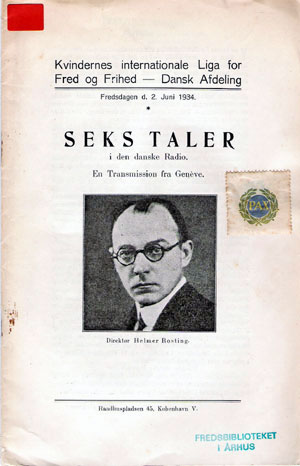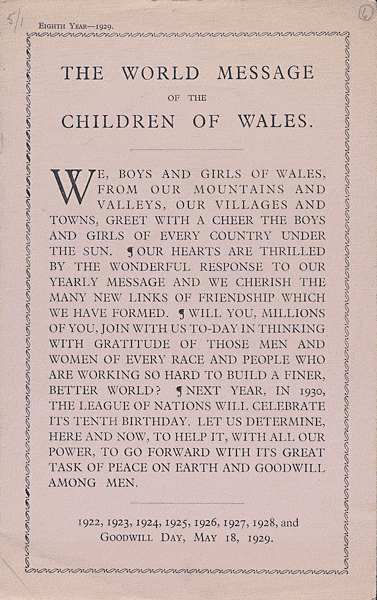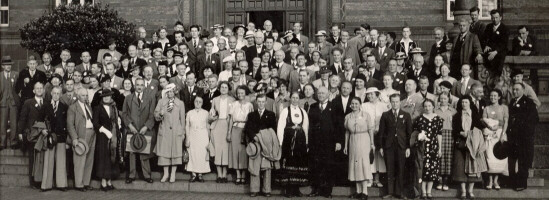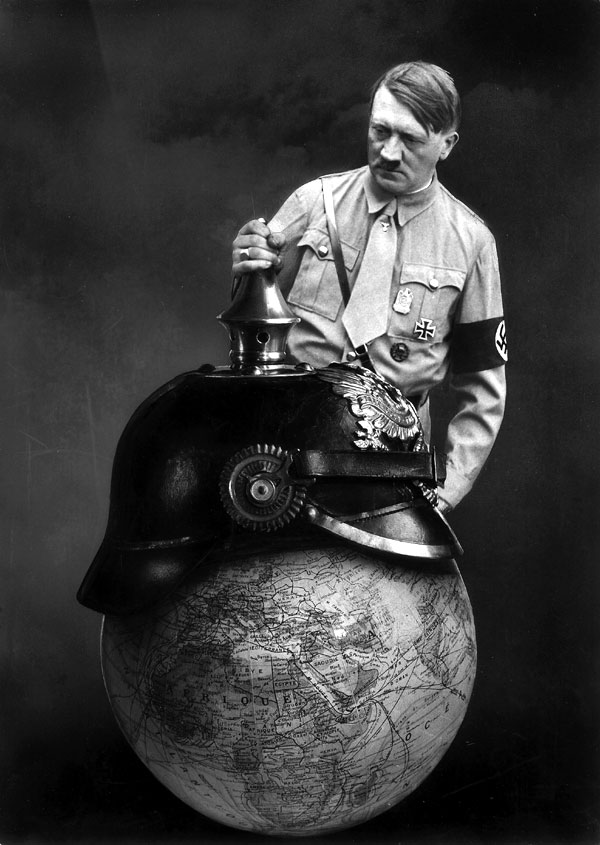The Danish Peace Academy
Holger Terp: Danish Peace History
Working paper 1
Denmark and the League of Nations
 |
 |
After Denmark joined the League of Nations in 1920, the Danish defence policy was adjusted accordingly. The Danish army and navy were disarmed; a policy even bourgeois politicians after much debate agreed on as no foreign threats were seen against Denmark112. According to George Lansbury's My Quest for Peace: “Very little money is spent on war preparations [in Denmark in 1938]. It would in any case be absurd for Denmark to arm against her enormously powerful southern neighbour. She has moreover no empire to hold by force, or to excite the covetousness of other countries. Iceland has the same King, but is in no other way dependent on Denmark. The Danish West Indies were sold to America early this century. The sole trace of the imperialist habits of the early Danes is the Danish flag that flies over the inhospitable Greenland.
The country is not out-and-out pacifist by any means. Conscription is still the law and there is a small "coast defence" which is hardly a real navy. But the policy of Denmark ever since the war has been to support earnestly every move which seemed to help peace. Nobody who considers the Danes' record can deny that their efforts have been genuine and continuous”113.
Though the Danish military was small in the 1920s, it were in several times used against striking workers114.
Danish politicians and idealists got involved with the promotion of the League of Nations. Accordingly the Danish Peace Society changed its name to The Danish Peace and League of Nations Society. When Fridtjof Nansen received the Nobel Peace Prize in 1922, the Danish publisher Christian Erichsen gave his whole fortune to Nansen, the matching amount of Nansen’s Nobel prize. Nansen gave the Nobel prize money and the money from Erichsen to humanitarian work in the Soviet Union.115.
Woman rights champion and pacifist Henni Forchhammer is speaking as the first woman in the League of Nations session against white slave trafficking, trafficking in women and children in December 1920.
The Day of Peace was one day a year, when the Danish Peace Society and the Women's International League for Peace and Freedom collected money. The first League of Nations Day, the first Monday in September, in Danish schools was celebrated on September 7, 1925. Also the Danish chapter of the Women's International League for Peace and Freedom broadcasted the world message of the Children of Wales. In 1930 on the League of Nations Day, September 10, the Danish Women's International League for Peace and Freedom gave ½ million young schoolchildren a bookmark with all the names of the League of Nations and a song »We praise the green hills» written by the poet Axel Juel (1883-1948).
While Germany was busy rearming and preparing for the Second World War, the War Resisters’ International held its international conference in Copenhagen in July 1937116. After the congress the Dutchman Bart de Ligt (1883-1938) published The Conquest of Violence in English and Fight without Weapons117 was published in Denmark of which later professor Gene Sharp made good use118.
Sharp wrote, ”that Lindberg attempted, and appealed for, a comparative evaluation on practical grounds of the advances, disadvantages and consequences of nonviolent action, military resistance, terrorist resistance and guerrilla war”119.
While responsible politicians declared ‘peace in our time’ the year following, informed pacifists, journalists and refugees knew better. Ellen Hørup established the international news agency: Journal des Archives, 1938-1939, in Geneva to communicate analyses of the current political situation in Europe to the rest of the world120. Because of criticism against the Swiss restricted policy towards German political émigrés, on February 2, 1939 the chief of the Swiss Police féderale des étrangers recommended that the residence permission of Ellen Hørup not was renewed. She moved to France121.
In May 1938 Ellen Hørup took the initiative to a three days international conference in the French town Marseille for prominent women on the subject “the morale in international relations”. The conference was attended by 700 women122.
I have failed to find research references to Journal des Archives in the international peace literature; so this subject awaits its historican.
The 5th Triennial Conference of the WRI, was in Copenhagen. 1937.

WRI 1937 Congress members at the Town Hall of Copenhagen as big picture.
Hitler in the eyes of the Danish John Heartfield, Marinus Kjeldgaard (1884-1964), printed in the French magazine Marianne.

Notes
112 Larsen, Knud: Forsvar og Folkeforbund : Et studie i Venstres og Det konservative Folkepartis forsvarspolitiske meningsdannelse 1918-1922, Aarhus, 1976.
113 Lansbury, George: My Quest for Peace.
1938 pp. 105-106. See also C. E. M. Joad’s Why War[?],
mentioned in the article ’En udlænding ser paa
Danmark’. In: Fred og Frihed,1939:4 p. 33. See also:
Communication by the Danish delegation to the Conference for the
Reduction and Limitation of Armaments. - Geneva : the League,
[1932]. - 7 p. ; Series of League of Nations publications. IX,
Disarmament ; 1931.IX.15.Annex.
http://digital.library.northwestern.edu/league/le000463.pdf
114 Petersen, Carl Heinrich: Fra klassekampens slagmark i Norden. - Århus : Modtryk, 1976.
115 Stensgård, Erling: En praktisk Idealist : En Bog om Chr. Erichsen. Århus, 1927. pp. 97-105
116 Four Days in Denmark : Triennial
Conference, 1937. In: The War Resister, 1937. No. 43 pp. 1-48.
'FOREWORD
In editing this report I have had to abridge many speeches and to
omit some altogether. I have tried to be fair and only to omit
opinions which have been adequately expressed elsewhere. After
reviewing the whole Conference and re-reading all the speeches, I
have formed the opinion that the International has reached a
position of importance and influence hardly dreamed of when it was
founded seventeen years ago. The Agenda was so over-crowded and we
worked so hard in a Conference that was twice its normal size, that
we missed much of the opportunity for intimate contact and social
intercourse which has been so valuable on former occasions.
At the close of the Conference we found that the International was
as resolute in its rejection of .the use of all forms of armed
violence as it had ever been, and unanimously re-affirmed our
Declaration in the words printed at the end of this report.
There was the usual desire for a plan of action in which all could
participate alike and the inevitable realisation that each must
work according to the opportunities which presented themselves in
their differing circumstances. A few had lost their faith in the
effectiveness of nonviolent resistance, but even those believed in
its ultimate Tightness. A few thought that some kind of economic
pressure could be used to restrain aggression. We rejected
sanctions imposed by imperialist governments, but recognised the
right and duty to withhold our co-operation in the wrong-doing of
tyrants and oppressors.
We frankly recognised that a warless world was not realisable
within the capitalist and imperialist system, and when we sought to
emphasise, as an immediate part of our programme, the effort to
prevent the next war, there were not lacking those who warned us to
beware that Governments, all of which were maintained by force of
arms, could not dispense with armed violence and retain their
power.
We desired an end of Authority, the end of the power or right to
demand, and that Governments should exercise purely administrative
functions. With that tolerance which has always characterised our
International, we granted the right of each to place the emphasis
upon the immediate objective of stopping the next war or upon the
long distance view of a new social order, as seemed to him
best.
A large number of the delegates were young men and women.
Especially noteworthy were the speeches of the two youngest; at the
commencement of the Conference that of a Frenchman 19 years of age
(see page 6), and at its close, that of a young German (see page
46).
This report is not complete without the review by the General
Secretary, Grace Beaton, of the work as a whole, published as a
supplement—price 3d. H. RUNHAM BROWN.'
Hørup, Ellen: Disarmament or
Rearmament. 1937.
Lansbury, George: My Quest for Peace. London 1938.
Conscientious objectors speak. In:
Prasad, Devi: War is a crime against humanity : The Story of the
War Resisters' International.
- London : WRI, 2005. - 553 s. - ISBN 0-903517-20-5 pp.
186-189.
In August 1979, WRI held its second triennial conference, 'Toward
Liberation' in Sønderborg, Denmark: WRI: 16th Triennal
Report August 13-17th Sønderborg, Denmark. - Bruxelles :
WRI, Correspondance Vol 2 no 6 - Publication Periodique. - 9 + 15
pp.
117 Kamp uden Vaaben : Ikke-Vold som Kampmiddel mod Krig og Undertrykkelse / Niels Lindberg ; Gammelgaard Jacobsen ; Karl Erlich. 1937 .
118 Sharp, Gene: The Politics of Nonviolent Action. Boston, 1973.
119 Sharp, Gene: The Dynamics of Nonviolent Action p. 569
120 It was described as “Service of international documentation. – Correspondents in London, Paris, Geneva, Zurich, Copenhagen and Chicago. Monthly Bulletin in three editions: English, French and German. Documents on political, economical and financial questions. Reproduction authorised and gratis, on condition of stating the source of origin and sending voucher numbers”. There is a copy of the English version at the Royal Library in Copenhagen.
121 Police fédérale des éstrangers, Case no. 778792 G/L. In: the Swiss Public Record.
122 Marseille-Kongressen. In: Fred og Frihed, 1938:5 p. 45.
Moralen i internationale Forbindelser. In: Fred og Frihed, 1938:4 p. 29. Some documents relating to the conference in Marseille are at the University of Colorado at Boulder: "I was able to find letters, registration, announcement, and newspaper articles about the conference in Marseille. Although I was unable to find any information about Ellen Horup. Most of the information is general and just descripes the conference. There are still some folders though that I was unable to get to in the free hour, these include:
WILPF Collection Accession 1:
Series I- Box 8 fd16
Box 6 fd 16-17
WILPF Collection Accession 2:
Box 12 fd 8-11
Box 46 fd 4
Box 148 fd 2
Sincerely,
Ashleigh Mayer
Student Assistant
|
|
|